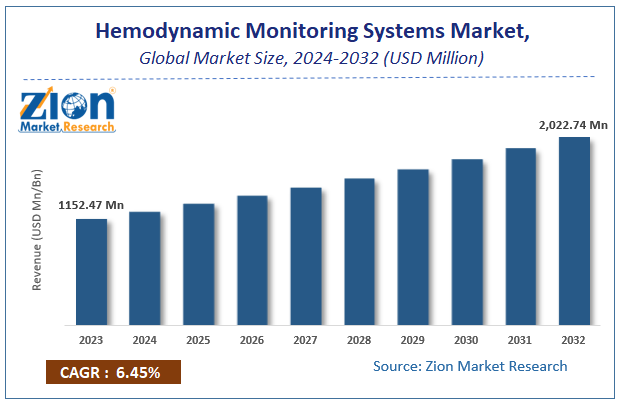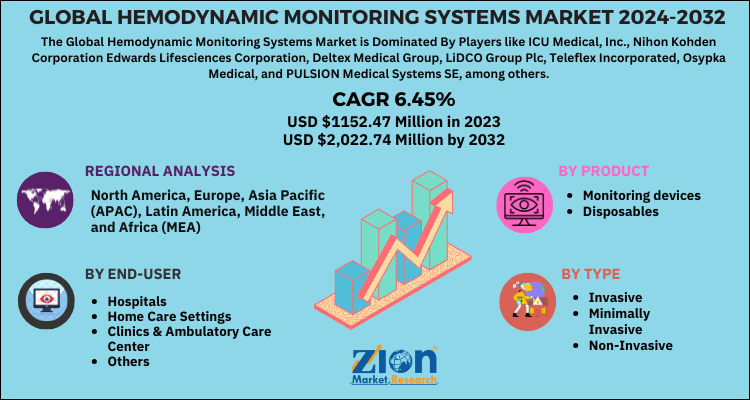Hemodynamic Monitoring Systems Market Size, Share, Trends, Growth 2032

Hemodynamic Monitoring Systems Market Analysis By Product (Monitoring devices, Disposables), By Type (Invasive, Non-invasive, and Minimally Invasive), By End-User (Hospitals, Home Care Settings, and Clinics & Ambulatory Care Center), and By Region: Global Industry Perspective, Comprehensive Analysis and Forecast, 2024-2032
| Market Size in 2023 | Market Forecast in 2032 | CAGR (in %) | Base Year |
|---|---|---|---|
| USD 1152.47 million | USD 2,022.74 million | 6.45% | 2023 |
Hemodynamic Monitoring Systems Market: Industry Perspective
The global Hemodynamic Monitoring Systems market size accrued earnings worth approximately USD 1152.47 Million in 2023 and is predicted to gain revenue of about USD 2,022.74 Million by 2032, is set to record a CAGR of nearly 6.45% over the period from 2024 to 2032. Request Free Sample
Request Free Sample
Global Hemodynamic Monitoring Systems Market: Overview
Hemodynamic monitoring systems are used to examine the patient’s blood flow in detail and obtain various metrics about it, such as the amount of oxygen in the blood and the blood pressure inside various parts of the circulatory system. Hemodynamic monitoring systems are of particular use in the post-surgical rehabilitation of cardiac patients, as their weakened cardiovascular systems need more attention. A hemodynamic monitoring system is used in cases where a patient’s cardiovascular health needs to be assessed, especially among those patients that have undergone cardiac surgery.
Global Hemodynamic Monitoring Systems Market: Growth Factors
The hemodynamic monitoring systems market is anticipated to grow steadily in the coming years due to the escalating patient demographic of cardiovascular diseases. Technological innovations in minimally invasive as well as non-invasive techniques used for hemodynamic monitoring will primarily drive hemodynamic monitoring systems market growth. The increasing prevalence of lifestyle-related diseases, such as diabetes, hypertension, and obesity resulting in heart-related disorders such as cardiac arrests, heart failures, and heart attacks will trigger the business space in the years to come.
Favorable schemes introduced by the government to create awareness about the cardiovascular and respiratory illness will further chart a profitable roadmap for the hemodynamic monitoring systems market in the years ahead. A massive number of hospital surgeries and a rising aging population are a few of the key growth drivers for the hemodynamic monitoring systems market. Favorable compensation policies in developed economies will push market growth. However, adverse reactions, such as bleeding, thrombosis, pulmonary capillary necrosis, sepsis, and hemorrhage, associated with invasive hemodynamic monitoring will inhibit the hemodynamic monitoring market expansion in the years to come.
Global Hemodynamic Monitoring Systems Market: Segmentation Analysis
The global hemodynamic monitoring systems market can be divided based on the product, type, and end-user.
Product-wise, the hemodynamic monitoring systems market is segmented into disposables and monitors.
Based on the type, the market is sectored into invasive, non-invasive, and minimally invasive types.
On the basis of the end-user, the market is divided into hospitals, home care settings, and clinics & ambulatory care centers.
Hemodynamic Monitoring Systems Market: Report Scope
| Report Attributes | Report Details |
|---|---|
| Report Name | Hemodynamic Monitoring Systems Market |
| Market Size in 2023 | USD 1152.47 Million |
| Market Forecast in 2032 | USD 2,022.74 Million |
| Growth Rate | CAGR of 6.45% |
| Number of Pages | 204 |
| Key Companies Covered | ICU Medical, Inc., Nihon Kohden Corporation Edwards Lifesciences Corporation, Deltex Medical Group, LiDCO Group Plc, Teleflex Incorporated, Osypka Medical, and PULSION Medical Systems SE, among others. |
| Segments Covered | By Type, By Application, and By Region |
| Regions Covered | North America, Europe, Asia Pacific (APAC), Latin America, Middle East, and Africa (MEA) |
| Base Year | 2023 |
| Historical Year | 2018 to 2022 |
| Forecast Year | 2024 - 2032 |
| Customization Scope | Avail customized purchase options to meet your exact research needs. Request For Customization |
Global Hemodynamic Monitoring Systems Market: Regional Analysis
Based on regions, the global hemodynamic monitoring systems market can be divided into five main regions: North America, Europe, Asia Pacific, Latin America, and the Middle East and Africa.
North America hemodynamic monitoring systems market is anticipated to contribute remarkably towards the overall hemodynamic monitoring systems market size in the coming years, owing to a surge in the number of cancer patients, cardiovascular patients, and the old population base.
Asia Pacific hemodynamic monitoring systems market is slated to experience considerable growth owing to the rising prevalence of cardiovascular and respiratory diseases, the advancement of healthcare infrastructure with rapid economic growth, increasing number of hospitals, large patient pool, and favorable government initiatives.
Latin America hemodynamic monitoring systems market is projected to witness considerable growth during the forecast timeline, owing to drastically altering lifestyles and massive popularity for Congenital Heart Disease Screening (CCHD) tests.
The Middle East & Africa hemodynamic monitoring systems market will experience moderate growth over the ensuing years with South Africa and Saudi Arabia being major contributors towards the regional growth.
Global Hemodynamic Monitoring Systems Market: Competitive Players
Some most important players of the global hemodynamic monitoring systems market are
- ICU Medical, Inc.
- Nihon Kohden Corporation Edwards Lifesciences Corporation
- Deltex Medical Group
- LiDCO Group Plc
- Teleflex Incorporated
- Osypka Medical
- and PULSION Medical Systems SE, among others.
Hemodynamic Monitoring Systems Market: Segments
By Product
- Monitoring devices
- Disposables
By Type
- Invasive
- Minimally Invasive
- Non-Invasive
By End-User
- Hospitals
- Home Care Settings
- Clinics & Ambulatory Care Center
- Others
By Region
- North America
- The U.S.
- Canada
- Europe
- France
- The UK
- Spain
- Germany
- Italy
- Rest of Europe
- Asia Pacific
- China
- Japan
- India
- South Korea
- Southeast Asia
- Rest of Asia Pacific
- Latin America
- Brazil
- Mexico
- Rest of Latin America
- Middle East & Africa
- GCC
- South Africa
- Rest of Middle East & Africa
Table Of Content
Methodology
FrequentlyAsked Questions
The hemodynamic monitoring systems market is anticipated to grow steadily in the coming years due to the escalating patient demographic of cardiovascular diseases. Technological innovations in minimally invasive as well as non-invasive techniques used for hemodynamic monitoring will primarily drive hemodynamic monitoring systems market growth.
Global Hemodynamic Monitoring Systems market size earned around $1152.47 M in 2023 and is expected to hit $2,022.74 M by 2032, with a projected CAGR of 6.45%.
North America hemodynamic monitoring systems market is anticipated to contribute remarkably towards the overall hemodynamic monitoring systems market size in the coming years, owing to a surge in the number of cancer patients, cardiovascular patients, and old population base.
Some main participants of the Hemodynamic Monitoring Systems market are ICU Medical, Inc., Nihon Kohden Corporation Edwards Lifesciences Corporation, Deltex Medical Group, LiDCO Group Plc, Teleflex Incorporated, Osypka Medical, and PULSION Medical Systems SE, among others.
RelatedNews
HappyClients
Zion Market Research
Tel: +1 (302) 444-0166
USA/Canada Toll Free No.+1 (855) 465-4651
3rd Floor,
Mrunal Paradise, Opp Maharaja Hotel,
Pimple Gurav, Pune 411061,
Maharashtra, India
Phone No +91 7768 006 007, +91 7768 006 008
US OFFICE NO +1 (302) 444-0166
US/CAN TOLL FREE +1 (855) 465-4651
Email: sales@zionmarketresearch.com
We have secured system to process your transaction.
Our support available to help you 24 hours a day, five days a week.
Monday - Friday: 9AM - 6PM
Saturday - Sunday: Closed





